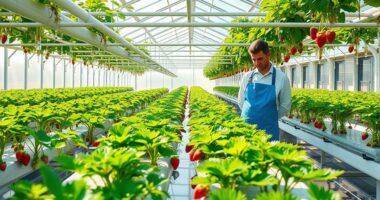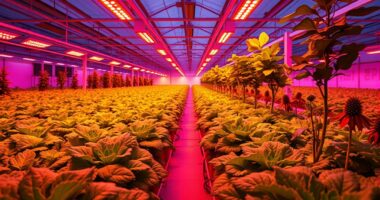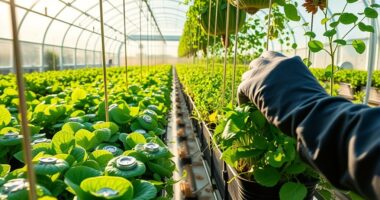Vertical farming systems in greenhouses combine hydroponic methods and LED lighting to produce crops efficiently all year round. You benefit from space-saving vertical layouts, reducing land use, and minimized water waste. LED lights provide the ideal wavelengths for each growth stage, boosting yield and quality. These systems create controlled environments that speed up growth cycles and lower resource consumption. Keep exploring further to discover how these innovations are shaping sustainable, high-tech agriculture.
Key Takeaways
- Vertical farming systems in greenhouses utilize hydroponics and LED lighting for efficient plant growth in limited spaces.
- They maximize land use by stacking crops vertically, ideal for urban and resource-constrained environments.
- Integrated LED strategies enable precise control over light spectra and schedules, accelerating crop cycles.
- These systems promote sustainability by reducing water, land, and energy consumption compared to traditional farming.
- Technological advancements enhance system automation, crop quality, and year-round production capabilities.

Vertical farming systems in greenhouses are transforming traditional agriculture by maximizing space and improving crop yields. As you explore these innovative setups, you’ll find that hydroponic systems are central to their efficiency. Hydroponic setups allow you to grow plants without soil, using nutrient-rich water solutions instead. This method reduces land use and minimizes water waste, making it ideal for limited spaces. It also speeds up plant growth, so you’ll see quicker harvests compared to conventional farming. When combined with vertical stacking, hydroponic setups make the most of every inch of space within the greenhouse, enabling you to cultivate more crops simultaneously. This approach is especially beneficial in urban areas, where land is scarce but demand for fresh produce remains high.
To maximize plant growth further, LED lighting strategies come into play. You’ll want to select LED lights that emit specific wavelengths tailored to different plant stages. During the vegetative phase, blue light encourages healthy foliage development, while red light during flowering helps boost fruit and flower production. LEDs are energy-efficient, generating less heat than traditional lighting, which allows you to position lights closer to the plants without risking damage. This proximity increases light absorption, promoting robust growth. Plus, programmable LED systems let you adjust light intensity and duration, mimicking natural sunlight or customizing the environment for particular crops. This control ensures plants receive exactly what they need, regardless of external weather conditions.
Integrating hydroponic setups with LED lighting strategies creates a highly controlled environment where you can fine-tune variables for ideal growth. You can set precise nutrient delivery schedules and light cycles that align with each crop’s requirements, leading to faster development and higher yields. This synergy also means you can extend growing seasons, produce multiple harvests annually, and maintain consistent crop quality. It’s a smart way to increase productivity without expanding your physical footprint. Furthermore, these systems reduce the reliance on pesticides and herbicides, resulting in cleaner, safer produce.
In essence, by leveraging hydroponic setups and LED lighting strategies within vertical farming systems in greenhouses, you’re adopting a sustainable, efficient approach to agriculture. You maximize every square inch, minimize resource consumption, and gain full control over your crop environment. This combination allows you to grow more food with less waste, all while maintaining high standards of quality and sustainability. As technology advances, expect these systems to become even more sophisticated, making vertical farming in greenhouses a cornerstone of future food production. Incorporating advanced technology further enhances system efficiency and crop management.
Frequently Asked Questions
What Are the Initial Costs for Setting up Vertical Greenhouse Farms?
The initial costs for setting up vertical greenhouse farms typically range from $200 to $500 per square foot, depending on your infrastructure requirements and technology choices. Your cost estimation should include investing in climate control systems, LED lighting, shelving, and automation equipment. Keep in mind, quality materials and advanced systems will increase costs but can improve efficiency. Planning carefully helps guarantee your vertical farm is both cost-effective and sustainable in the long run.
How Do Vertical Systems Impact Greenhouse Energy Consumption?
Vertical systems can increase your greenhouse’s energy consumption initially, mainly due to lighting efficiency needs and ventilation strategies. However, by optimizing LED lighting and implementing smart ventilation, you can reduce overall energy use. Vertical setups often allow for better climate control and targeted lighting, which can lead to energy savings over time. So, while initial energy demands may rise, smarter systems help you manage long-term efficiency effectively.
Are Vertical Farming Systems Suitable for All Crop Types?
You can’t judge a book by its cover, and the same goes for vertical farming systems. They aren’t suitable for all crop types because of differences in crop diversity and plant adaptability. Leafy greens and herbs thrive in vertical setups, but large fruits or root vegetables often struggle. To succeed, match crop choices with system capabilities, recognizing that some plants simply adapt better to vertical environments.
What Maintenance Challenges Are Unique to Vertical Greenhouse Farms?
You’ll face unique maintenance challenges like pest management, which requires careful monitoring to prevent infestations without harming crops. Water quality is also critical; you need to regularly test and maintain clean, pathogen-free water to ensure healthy plants. Additionally, controlling humidity and airflow can be tricky, but doing so helps prevent mold and disease. Staying vigilant with these aspects keeps your vertical greenhouse farm running smoothly and productively.
How Scalable Are Vertical Farming Systems for Commercial Operations?
Vertical farming systems are highly scalable for commercial operations, especially when you focus on urban integration and technological innovation. By leveraging compact designs and modular setups, you can expand your farm efficiently within limited spaces. Embracing advanced automation and IoT technologies further streamlines operations, making it easier to increase production without significant infrastructure overhauls. This approach allows your vertical farming venture to grow sustainably while adapting to urban environments and evolving market demands.
Conclusion
Imagine your greenhouse as a lush skyscraper reaching toward the sky, where vibrant plants flourish in harmony. Vertical farming systems transform your space into a symphony of growth, maximizing every inch with nature’s artistry. By embracing these innovative methods, you become a gardener of the future, cultivating abundance from the ground up. Let your greenhouse be a beacon of sustainability and hope, where life blossoms vertically and dreams grow tall, reaching for the sun.









